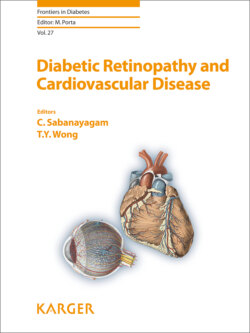Читать книгу Diabetic Retinopathy and Cardiovascular Disease - Группа авторов - Страница 13
На сайте Литреса книга снята с продажи.
Diabetes and Vascular Disease Mechanisms
ОглавлениеDiabetes mellitus is a metabolic disorder characterised by chronic hyperglycaemia as well as disruption to fat, carbohydrate and protein metabolism. Hyperinsulinaemia, insulin resistance and pancreatic β-cell failure are typical of type 2 diabetes. Type 1 diabetes is an immune-mediated condition, usually with detectable autoantibodies, which results in the destruction of β-cells and insulin deficiency. Other rarer forms of diabetes include, among others, monogenic diabetes, drug-induced diabetes and diseases of the exocrine pancreas.
Diabetes complications are traditionally classified into microvascular complications such as neuropathy, retinopathy and nephropathy; and macrovascular complications such as ischaemic heart disease, stroke and peripheral arterial disease. Ischaemic heart disease remains the most common cause of mortality in patients with diabetes, typically presenting at an earlier age, with greater severity and more diffuse atherosclerotic disease than in patients without diabetes [10]. More recently, heart failure has emerged as an important manifestation of heart disease in people with diabetes. While it may be a consequence of coronary artery disease and myocardial infarction, there is strong evidence of a direct metabolic effect on cardiac function, leading to fibrosis and stiffness of the ventricles and reduced filling volumes [11]. Indeed, recent data show that, in diabetes, heart failure frequently presents before there have been any clinical episodes of coronary artery disease [12].
Mechanisms for the development of atherosclerotic cardiovascular disease associated with hyperglycaemia include endothelial dysfunction, hypercoagulability, advanced glycation end product formation, increased platelet reactivity, increased oxidative stress and increased inflammation [10, 13]. Due to shared risk factors, people with diabetes often have concomitant disorders contributing to their cardiovascular risk, such as hypertension, dyslipidaemia, obesity and obstructive sleep apnoea. Furthermore, insulin-resistance, even prior to the onset of hyperglycaemia, may affect lipid metabolism directly, leading to elevated triglycerides, low high-density lipoprotein and small dense low-density lipoproteins (LDL) [10]. This pattern of dyslipidaemia is known to be atherogenic.
